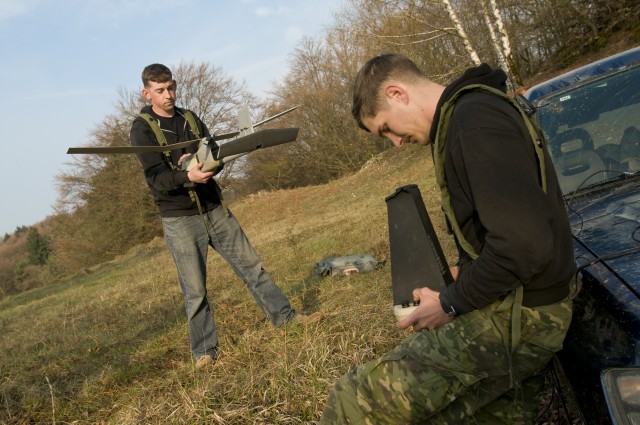HOHENFELS, Germany (April 12, 2016) -- Sgt. Kyle Head and Spc. Zachary Young from C Company, 1st Battalion, 4th Infantry Regiment have been piloting an unmanned aerial vehicle as part of Saber Junction 16 at Hohenfels, Germany.
Both play roles as opposing forces, working to thwart Allied and U.S. partner efforts throughout the exercise.
"This keeps our skills up. It allows us to retain better situational awareness for our unit," said Head.
The RQ-11B DDL Raven is a small plane, better known as a unmanned aerial system (UAS). It is an aircraft without a pilot on board. Instead, it is remotely controlled on the ground or can be preprogrammed to fly autonomously based on flight plans. With a wingspan of 4.5 feet and weighing only 4.2 pounds, it is small enough to be held and launched by hand.
Head says the training allows his unit to communicate better with foreign national partners. "Being able to share different data and imagery that we are able to pick up and help them as an informational standpoint."
Young has been flying for about a year now, but this is his first rotation inside of the Box, the U.S. Army's 40,000-acre Hohenfels training area in southeastern Germany. Part of his job as a Raven pilot is to relay the information he learns to his command.
"You and that one other individual in a team have to see everything," said Young. "You're responsible for calling up to a lieutenant colonel or company commander. You're in the whole grind of everything and you are a really good asset for reporting things."
Young says he's learned a lot from flying the Raven, day and night, simply from observing. "From an infantryman's standpoint, I've always been in a line unit. I've never actually had the chance to just sit there and watch over something for hours on end. This way, it's like a way of studying your enemy and figuring out what they're going to do next."
Much of their mission takes place at night under the cover of darkness. The drone is equipped with the ability to see infrared light, illuminating the nighttime battlefield. Cameras onboard film the flight and send a live video feed back to the camera operator on the ground.
After preflight checks, the pair usually takes the Raven in the air for about 45 minutes before returning it.
The Raven supports battalion and company sized elements to provide reconnaissance and scout missions. In the absence more sophisticated drones the Raven is combat multiplier for Army infantry battalions.






Social Sharing